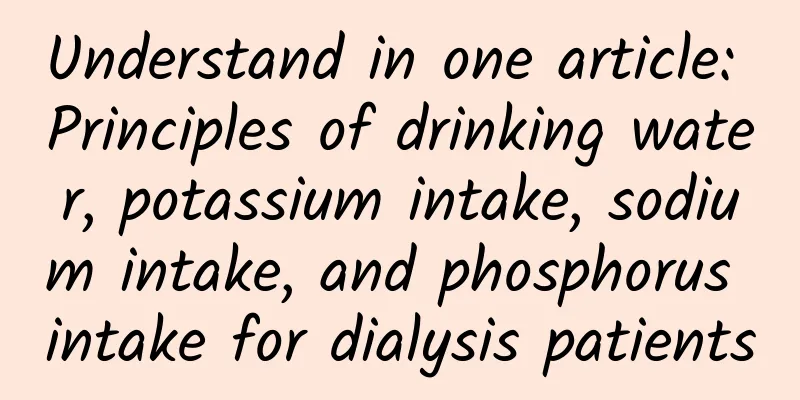Understand in one article: Principles of drinking water, potassium intake, sodium intake, and phosphorus intake for dialysis patients

|
In addition to a low-protein diet, it is also important for dialysis patients to ensure daily energy supply and vitamin supplementation, as well as drinking water, potassium intake, sodium intake, and phosphorus intake. Today, we will show you what dialysis patients need to pay attention to in these aspects. How do hemodialysis patients drink water? When the patient does not have edema or hypertension and the daily urine volume is greater than 1500 ml, there is basically no limit on the amount of water to drink, as long as the weight gain between dialysis sessions does not exceed 5% of the dry body weight. The amount of water that patients on maintenance hemodialysis should drink is the sum of the urine volume of the previous day plus 500 to 800 ml of insensible water loss. In addition, food also contains water, so it cannot be ignored. Tips for controlling water intake: (1) Foods such as porridge, fruits, and canned products contain a lot of water, so do not eat too much. (2) Do not eat food that is too salty. (3) Eat a light diet, cook your own meals, and use less MSG. (4) Patients with low urine output should avoid drinking porridge or soup as much as possible. Tips for controlling water intake: Evenly distribute the amount of water you can drink in a day, put it in a container with a scale or mix some water with lemon juice to make ice cubes, hold them in your mouth when you are thirsty, and let the ice cubes melt slowly. When you are slightly thirsty, you can moisten your lips with a cotton swab or rinse your mouth, and drink water in small sips when you are very thirsty. Principles of potassium-restricted diet for dialysis patients The amount of potassium in the diet depends on the urine volume and blood potassium level. Potassium is excreted when there is urine, and potassium is basically unlimited or slightly limited when the urine volume exceeds 500 ml; the daily potassium supply for anuric hemodialysis patients is less than 2 grams, especially for diabetic nephropathy patients; the daily potassium supply for anuric peritoneal dialysis patients is 3 to 4 grams. The potassium in food is mostly concentrated in the husk, peel and flesh of grains, and potassium is easily soluble in water. Thick vegetable soup, fruit juice and broth all contain a considerable amount of potassium, so the following methods can be used to reduce potassium intake. 0 1 Vegetables After blanching in boiling water, pick up the food and stir-fry or mix with a small amount of oil. Avoid eating vegetable soup and lettuce. 0 2Fruit Avoid eating high-potassium fruits such as kiwi, cantaloupe, strawberry, date, banana, etc. 0 3 Meat Do not eat rice with condensed soup or gravy. 04 Beverages Avoid coffee, tea, sports drinks, etc. 05Seasoning Do not use low-sodium salt, healthy and delicious salt, and salt-free soy sauce that use potassium salt instead of sodium. 06Others Nuts, chocolate, tomato sauce, dried fruits and medicinal soups are high in potassium and should be avoided. Sodium restriction diet for dialysis patients Patients with oliguria or anuria, accompanied by edema, hypertension or congestive heart disease, need to follow a sodium-restricted diet. A sodium-restricted diet should avoid processed foods, such as pickled and cured products, canned foods, etc., and be cautious in using condiments such as soy sauce, black vinegar, monosodium glutamate, chicken essence, chili sauce, and bean paste, and only use low-sodium salt and salt-free soy sauce. Condiments such as sugar, white vinegar, wine, pepper, five-spice, star anise, lemon juice, coriander, onion, ginger, and garlic can be used to increase the palatability of food. However, it is also necessary to avoid excessive sodium restriction to prevent the occurrence of hyponatremia. Phosphorus-restricted diet principles for dialysis patients Patients with chronic renal failure are prone to hyperphosphatemia. The key to treating secondary hyperparathyroidism in chronic renal failure is to control phosphorus metabolism, an important part of which is to actively limit the phosphorus content in the diet. In short, if dialysis patients want to be in better health, they must strictly control their dietary intake while undergoing dialysis. Only in this way can they achieve better treatment effects and improve the quality of life of dialysis patients. |
<<: You can tell whether you have kidney disease by looking at your urine!
>>: Deadly skin infection: Necrotizing fasciitis
Recommend
How many follicles does a normal ovary have? The truth is this
There are two basic conditions for a woman to bec...
What is renal colic? How to use medication in clinical practice? Read this article to understand!
Renal colic is one of the most common acute abdom...
How long after cone biopsy can I have sex?
Many patients believe that after surgery, their b...
A guide to health care during a woman's 28-day cycle
Women's menstrual cycle is directly related t...
2023CCHIO Exclusive Interview | Professor Chen Xiaobing: Early detection and early treatment of esophageal cancer can help you regain a better life
The occurrence of esophageal cancer is actually c...
What causes acne on female genitals?
Women's private parts are sensitive and myste...
Is it normal for my period to come 4 days early?
Among the vast majority of our female compatriots...
If you open the "Nezha" series of movies like an ophthalmologist
🚀Has everyone watched the movie "Nezha 2&quo...
Do you wake up with unbearable neck pain? Stiff neck is hard to prevent, here are some tips to help you quickly relieve it
I felt everything was normal yesterday, but when ...
What functions does a smart TV have? How to connect a router to a smart TV
Smart TVs came along with the development of the ...
What to do if your menstrual flow is heavy and lasts for a long time
Under normal circumstances, women will have a men...
Can I eat yam during menstruation?
Huaishan is a kind of yam, which contains a lot o...
Can candidal vaginitis be cured?
Vaginitis is a gynecological disease that women a...
Small pimples on the breast
Breasts are a symbol of feminine charm and are al...
How to treat cervical cyst
Cervical cyst is a cyst that occurs in the neck. ...









